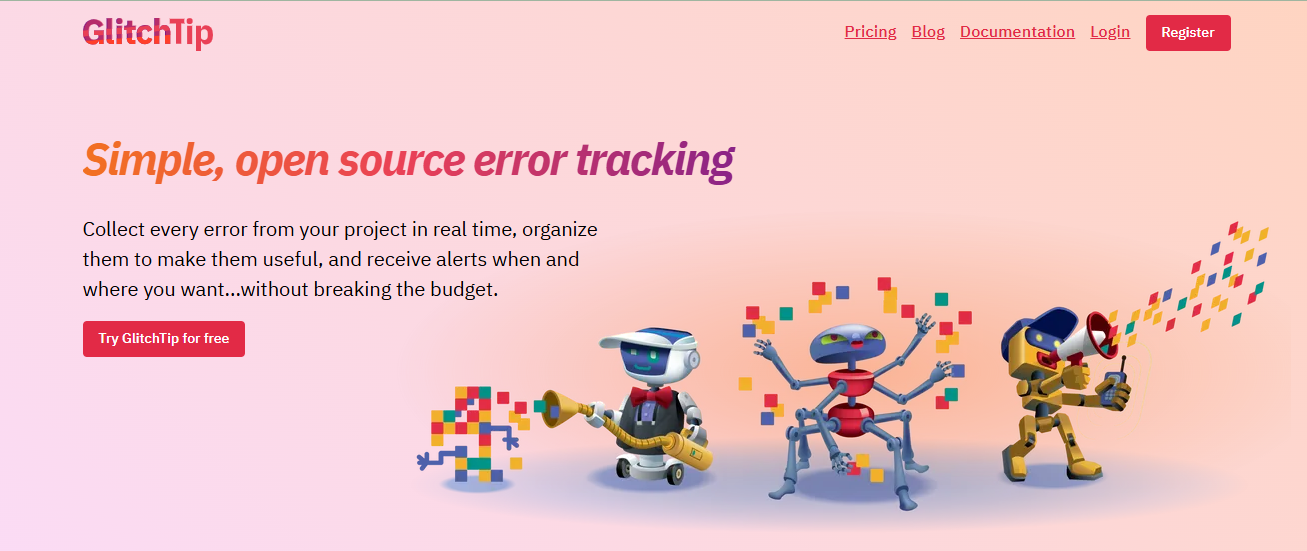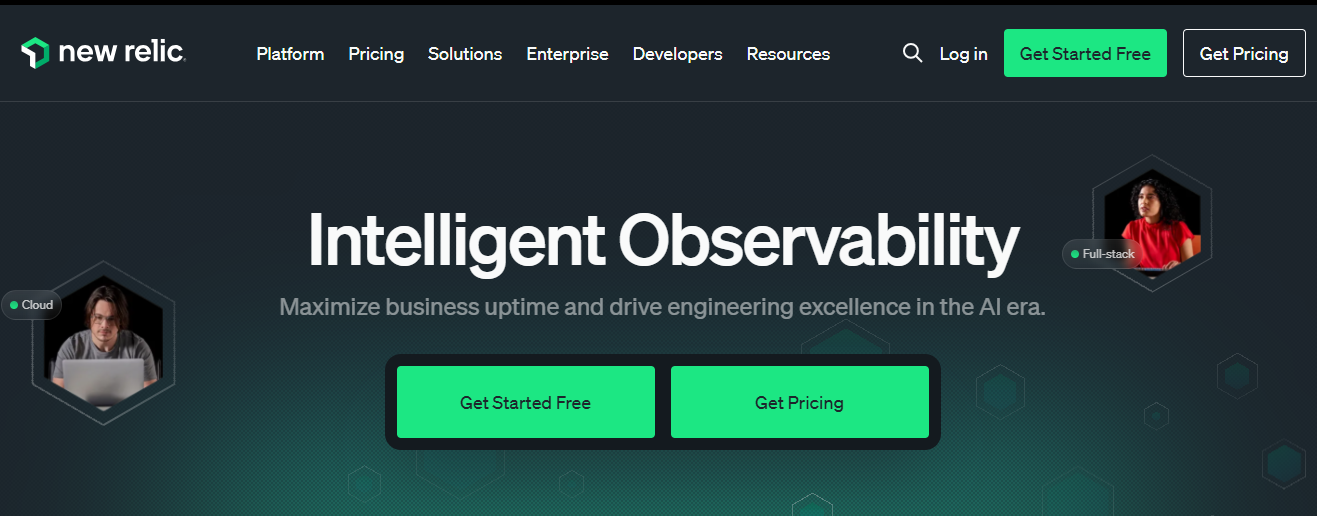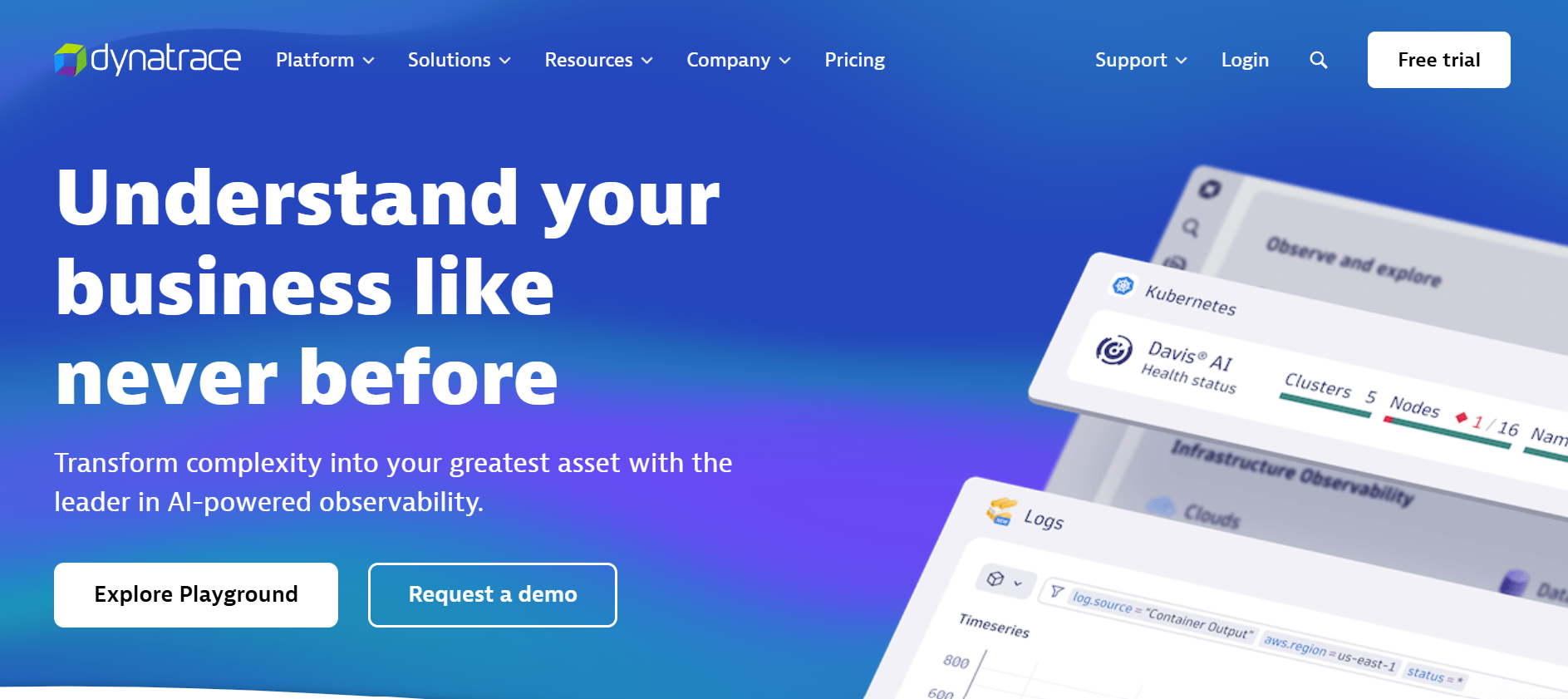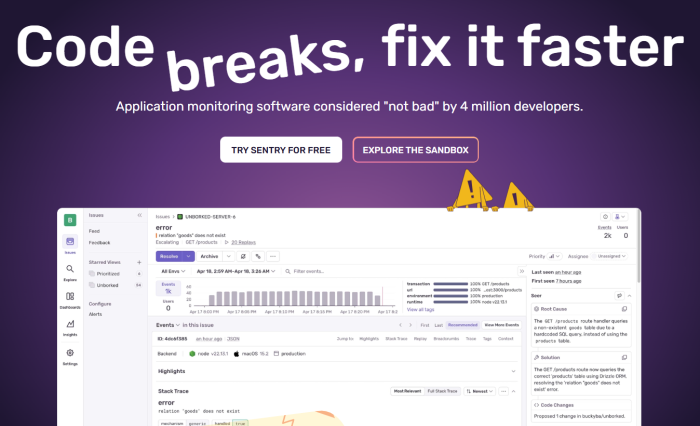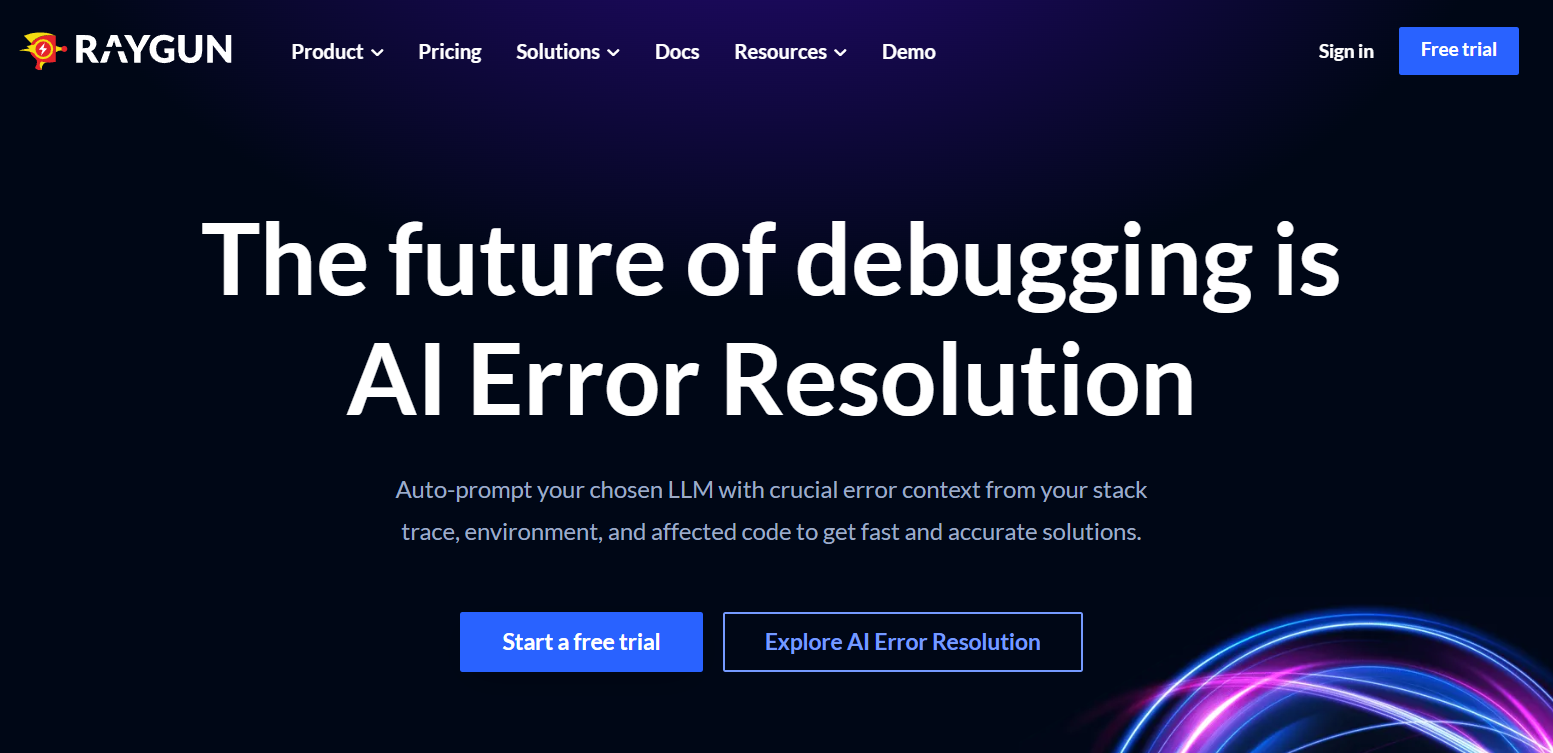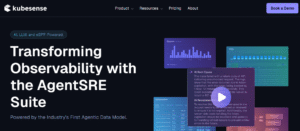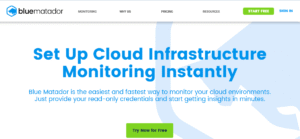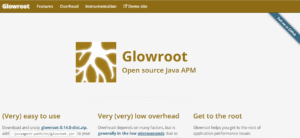GlitchTip is an open-source, Sentry-compatible error monitoring tool designed for simplicity, privacy, and affordability. As of mid-August 2025, GlitchTip is deployed by approximately 115 live websites and has been used by around 160 organizations in total. Developers seeking a lightweight, self-hosted error-tracking solution are its major users.
Despite these benefits, GlitchTip presents notable challenges. It lacks full observability, comes with limited dashboards, doesn’t support distributed tracing or comprehensive logs, and provides minimal scalability guidance..
CubeAPM is the best GlitchTip alternative, delivering full MELT observability, native OpenTelemetry support, and intelligent smart sampling. It offers flexible self-hosting, highly cost-effective pricing, and quality responsive support with the modern APM power.
In this article, we’re going to cover the best alternative to GlitchTip, comparing each across features, pricing, deployment flexibility, and ideal use cases to help you select the best match for your team.
Table of Contents
ToggleTop 7 GlitchTip Alternatives
- CubeAPM
- Datadog
- New Relic
- Dynatrace
- Sentry
- SigNoz
- Raygun
Why Are People Looking for GlitchTip Alternatives?
Pricing Predictability Challenges
GlitchTip’s hosted pricing follows a simple monthly event cap model—$15 for 100k events, $50 for 500k events, and $250 for up to 3 million events. While this is straightforward for steady workloads, it becomes unpredictable during traffic surges or incidents. A single widespread error spike can push a team from a $50 tier to the $250 tier overnight, without providing any additional observability capabilities. This unpredictability is a major concern for growing businesses or those operating in volatile environments.
Example: 3 TB/month Telemetry Scenario
- GlitchTip:
- Large Plan at $250/month covers up to 3 million events (errors/transactions).
- No native support for storing or querying 3 TB of logs/traces; this would need external tooling like ELK, Loki, or Prometheus.
- Adding such tooling for 3 TB/month can easily run $2,000–$4,000/month in infrastructure or vendor fees, depending on retention and query load.
GlitchTip alternative, for instance, CubeAPM costs $0.15/GB of data you ingest. For 3TB/month → 3,000 GB at $0.15/GB = $450/month in total for error tracking + full MELT observability in one platform.
Limited Observability
GlitchTip is strong at error tracking and basic uptime/performance, but it does not provide full MELT observability (deep logs + traces with rich correlation) at the level teams expect from modern APM suites. Community comparisons consistently note that while it accepts “transaction” events, it lacks the depth of distributed tracing and advanced dashboards found in larger platforms; even GlitchTip’s own docs and release notes emphasize incremental uptime/perf changes rather than end-to-end tracing.
Self-Hosting Complexity
GlitchTip’s self-hosting can cut licensing costs but adds heavy operational overhead. Deployments require PostgreSQL, Redis (or Valkey), worker and web services, and often load balancers. Scaling for high volumes needs tuning, storage, and orchestration tools, while updates risk halting event processing. Without dedicated expertise, smaller teams may face degraded performance, missed events, or downtime. (GitHub, DevOps.dev)
Integration Limitations
GlitchTip is compatible with the Sentry API, which allows use with some existing Sentry-compatible tools. However, integration with newer frameworks or specialized infrastructure often lags behind, and the number of officially documented connectors is limited. This means fewer ready-to-use options for CI/CD pipelines, cloud-native environments, and alerting platforms. Teams working with diverse technology stacks may need to develop and maintain custom integration bridges, adding to operational overhead..
Documentation Gaps
GlitchTip’s documentation explains setup and deployment basics but lacks detailed guidance for high-throughput scenarios. Key topics like retention policies, sampling strategies, and cost optimization under heavy load are not addressed, leaving growth-stage teams to rely on guesswork or community support.
Criteria for Selecting GlitchTip Alternatives
Full MELT Observability
A strong alternative should provide integrated Metrics, Events, Logs, and Traces, allowing engineers to connect issues across layers in one place. This eliminates the need for juggling multiple tools and speeds up root-cause analysis during incidents.
OpenTelemetry (OTEL) Support
Native support for OTel means compatibility with many SDKs and exporters, preventing vendor lock-in. This is essential for future-proofing your observability stack and unifying telemetry collection across all services.
Transparent and Predictable Pricing
Look for a model that scales linearly with actual usage—whether based on data volume or resource count—so teams avoid sudden jumps in cost during traffic spikes. This helps with budgeting and long-term cost control.
Deployment Flexibility
A good tool should support SaaS, self-hosted, or hybrid setups to match your compliance and infrastructure needs. Self-hosting is especially important for organizations with strict data residency requirements.
Advanced Sampling and Retention Controls
Intelligent sampling (head/tail/context-aware) and customizable data retention help keep storage costs manageable while retaining valuable telemetry for analysis. This is key in high-throughput environments.
Broad Integration Ecosystem
Pre-built connectors for CI/CD tools, cloud services, alerting systems, and ticketing platforms reduce setup time and ensure smooth integration into existing workflows.
Quality Support and SLAs
Fast, reliable support—via chat, email, or dedicated channels—can drastically reduce downtime during issues. Clear SLAs boost team confidence in choosing a vendor based on how responsive they are.
GlitchTip Overview
Known for
GlitchTip is an open-source error monitoring tool compatible with Sentry and offers error tracking, basic performance monitoring, and uptime alerts. It supports both hosted and self-hosted deployments, making it a popular lightweight option for teams seeking control and affordability. It’s ideal for teams that need monitoring but without the complexities of full APM tools.
Standout Features
- Error Tracking & Performance: Captures exceptions and slow transactions with minimal setup.
- Uptime Monitoring: Built-in health checks with alerts via email or webhook.
- Sentry SDK Compatibility: Works with existing Sentry clients for an easier migration path.
Key Features
- Error Tracking: Aggregates exceptions, logs, and environment metadata in real time.
- Performance Monitoring: Detects slow web requests and database operations without complex dashboards.
- Uptime Monitoring: Schedules endpoint checks and sends alerts if services go down.
- Hosted & Self-Hosted Deployment: Available as SaaS or self-hosted via Docker Compose or Kubernetes Helm.
- Notification Channels: Supports email and webhook alerts.
- Project Management: It helps you manage multiple projects and track their status.
Pros
- Open-source and Sentry-compatible, making migration easier
- Lightweight and simpler to deploy than full Sentry
- Combines errors, performance, and uptime monitoring in one tool
- Transparent pricing with a free tier and affordable paid plans
Cons
- Self-hosting requires managing PostgreSQL, Redis, web services, and worker processes
- UI is basic and lacks advanced dashboards or deep filtering
- No distributed tracing, metrics, or log correlation
- Limited official documentation for scaling high-throughput environments
Best for
Teams wanting a cost-effective, open-source alternative to Sentry for essential error tracking, basic performance insights, and uptime monitoring—particularly where self-hosting or simplicity is a priority.
Pricing & Customer Reviews
- Pricing: Free tier (1,000 events/month), Paid: $15/month for 100k events, $50 for 500k, $250 for up to 3M events.
- GitHub stars: 87
- Praised for: Lightweight, easy to self-host, and straightforward to set up.
- Criticized for: The UI is not advanced, and fewer observability features.
Top 7 GlitchTip Alternatives
1. CubeAPM
Known for
CubeAPM delivers enterprise-grade, full-stack observability that offers metrics, logs, traces, real user monitoring (RUM), synthetics, database monitoring, infrastructure insights, and error tracking. It replaces the need for multiple disconnected tools, helping teams reduce complexity while improving visibility and control. Known for its cost efficiency, OTEL-native architecture, and compliance-ready deployment options, CubeAPM enables organizations to monitor at scale without vendor lock-in or budget overruns.
Standout Features
- Full MELT Coverage: A complete observability stack including distributed tracing, logs, error inbox, RUM, synthetics, infra metrics, service graphs, custom metrics, dashboards, SLOs, alerts, and exception stack traces
- Smart Sampling: Context-aware sampling that prioritizes high-value telemetry such as error events and latency anomalies, cutting ingestion costs significantly without losing key insights
- Data Security & Compliance: Option to store all data in your own cloud or geographic region to meet GDPR, HIPAA, and enterprise compliance requirements
- Pre-Built Dashboards & Intuitive UX: Ready-to-use dashboards with a clean, fast interface for rapid onboarding and monitoring
Key Features
- OpenTelemetry Native: Ingests and exports OTEL data for seamless interoperability and vendor-neutral monitoring
- Full Observability Stack: Combines APM, logs, metrics, RUM, synthetics, and alerts into one integrated platform.
- Simple Pricing: Flat-rate ingestion and transfer model with no per-user or per-feature charges
- Enterprise Features: Role-based access control (RBAC), single sign-on (SSO), MFA, audit logging, high-availability clustering, and extended retention options
Pros
- Supports 800+ integrations across tools and services
- Consolidates multiple observability tools into one
- OTEL-native, avoiding vendor lock-in
- Smart sampling significantly reduces costs
- No egress charges
- Enterprise-ready with advanced access control and security
Cons
- Observability-focused platform; doesn’t provide cloud security management capabilities
- May not suit teams looking for SaaS-only platforms
Best for
Organizations of all sizes, particularly SaaS providers, fintechs, healthcare firms, and large enterprises, need a unified, cost-efficient observability platform with flexible deployment options and strong compliance features. Ideal for teams replacing multiple tools with one integrated system that scales predictably.
Pricing & Customer Reviews
- Pricing: Starts at $0.15/GB of data ingested.
- Score: 4.8/5
- Praised for: Smart sampling, full-stack MELT coverage, ease of migration, transparent pricing, and responsive support
CubeAPM vs GlitchTip
GlitchTip focuses on error tracking and offers basic APM, but doesn’t offer the full MELT stack, enterprise-grade controls, and advanced cost-optimization features. CubeAPM provides all telemetry types, OTEL-native flexibility, and compliance-ready deployments in a single platform—making it a future-proof choice for teams needing depth, scalability, and predictable pricing.
2. Datadog
Known for
Datadog is a cloud-native observability and security platform, offering metrics, logs, traces, RUM, synthetics, application performance, infrastructure monitoring, and security—all in a single, cohesive service. It excels at rapid deployment across complex environments and offers powerful dashboards, AI-driven anomaly detection, and vendor-backed integrations. Ideal for teams prioritizing full-stack visibility, rich context, and scalability.
Standout Features
- End-to-End Observability: Full visibility into infrastructure, applications, logs, traces, RUM, synthetics, and security from one platform
- AI-Powered Detection (Watchdog): Automated anomaly detection that identifies and surfaces unusual patterns and incidents proactively
- 900+ Integrations: Extensive vendor-backed integrations, especially strong in cloud providers, databases, and middleware
- LLM & AI Observability: Innovative support for tracing and securing LLM-driven workflows, with insights into token usage, latency, and error flows
Key Features
- Infrastructure & APM Monitoring: Monitors hosts, containers, serverless, and services—capturing metrics, events, logs, and traces
- Fine-Grained Sampling Controls: Configure trace sampling at the host, service, or endpoint level directly from the UI for cost-performance tuning
- OpenTelemetry Support: Supports both native and hybrid OTEL setups for vendor-neutral data collection
- Custom Alerts & Dashboards: Build trigger-based alerts across any metric or log, and design intuitive dashboards with synchronized views
- Security & Compliance Suite: Includes SIEM, workload protection, sensitive data scanning, and audit trails for unified observability and security
Pros
- Extremely rich feature set across observability and security
- Exceptional integration breadth across technologies
- AI-powered detection enhances proactive monitoring
- Mature, battle-tested SaaS solution with global scalability
Cons
- Tiered pricing can be expensive and complex, especially with host-based billing
- High-water-mark host billing can penalize elastic architectures
- Many features are “add-ons,” requiring separate subscriptions and higher costs
- Advanced usage can lead to unpredictable monthly bills
Best for
It’s best suited for large or fast-growing organizations, especially cloud-native enterprises, MSPs, and teams managing microservices, looking for a consolidated, feature-rich observability and security platform with extensive integrations and AI-driven insights..
Pricing & Customer Reviews
- Pricing Model: Infrastructure monitoring starts at ~$15 per host/month; APM adds ~$31/host; log management is ~$0.10 per GB; synthetic monitoring ranges per test type
- G2 rating: 4.4/5
- Praised for: Unified visibility across stacks, seamless integrations, and automated detection capabilities
- Criticized for: High cost complexity, especially in dynamic or microservice-heavy environments where host count fluctuates
Datadog vs GlitchTip
GlitchTip offers lightweight, open-source error tracking with basic performance metrics—ideal for low-cost, simplistic setups. In contrast, Datadog delivers full-stack observability, AI-driven insights, real user and synthetic monitoring, and enterprise-level integrations and security features. While powerful, Datadog comes with higher complexity and cost, making it suitable for teams that need deep, scalable visibility and are willing to invest in a premium SaaS platform.
3. New Relic
Known for
New Relic is a fully integrated, cloud-native observability and intelligence platform that provides APM, infrastructure, logs, traces, RUM, synthetics, security, and business observability. It also offers advanced AI/LLM-powered insights and deep instrumentation capabilities. It focuses on visibility across complex stacks and easy onboarding.
Standout Features
- Observability Across 50+ Capabilities: Covers APM, infrastructure, logs, distributed tracing, mobile/browser RUM, synthetics, error inbox, dashboards, alerting, change tracking, and more
- New Relic AI & LLM Assistants: Offer natural-language insights, health reporting, alert gap analysis, and AI-powered troubleshooting workflows
- Plenty of Integrations: Connects to 780+ built-in integrations across clouds, stack components, frameworks, and DevOps tools
- Custom Query Language (NRQL): Powerful, SQL-like query language to slice and analyze telemetry data across your stack in real time
Key Features
- APM & Infrastructure Monitoring: Real-time insights into services, hosts, containers, serverless, and networks
- Log Management: Free tier with 100 GB/month of log ingestion; intuitive, contextual log analysis integrated with trace and metric views
- Synthetic & RUM Monitoring: Simulates user paths with synthetic tests and monitors real user behavior directly in browser/mobile apps
- Alerting & Dashboards: Flexible rule-based alerts, incident correlation, and highly customizable dashboards for observability workflows
- Business Observability & Security: Includes vulnerability detection, SAP monitoring, cost intelligence, and customer journey mapping tools
Pros
- Deep, real-time visibility across services, infrastructure, user experience, and security
- Highly intuitive dashboards and dashboards with advanced monitoring controls
- Strong AI and LLM features that assist with diagnostics and alert insights
- Generous free tier with broad feature access and usage-based pricing
Cons
- An extensive feature set can overwhelm new users and contribute to a steep learning curve
- Pricing can become complex and costly as usage scales—especially with host and data-based charges
- Resource overhead can be noticeable, especially in large instrumented environments
Best for
Mid-to-large organizations—especially SaaS businesses, enterprises, and teams managing complex or hybrid architectures—seeking deep, unified observability, AI-driven insights, and highly flexible monitoring tools, and who are willing to invest in a comprehensive, premium-grade platform.
Pricing & Customer Reviews
- Pricing Model: Free tier includes 100 GB/month log ingestion and core usage. Ingestion-based pricing of $0.35/GB and $418/user/month for full access.
- G2 rating: 4.4/5
- Praised for: Rich, contextual visibility, real-time diagnostic tools, powerful AI features, and unified cross-stack monitoring
- Criticized for: Cost complexity, high resource footprint, steep learning curve, and UI density for new users
New Relic vs GlitchTip
GlitchTip excels at open-source, straightforward error tracking and basic performance monitoring with minimal fuss and cost. In contrast, New Relic offers full-spectrum observability—including diagnostics across RUM, logs, metrics, alerts, and AI-driven insights—in a polished SaaS platform. While New Relic offers unmatched feature depth and analysis capabilities, it also demands a higher investment of budget, infrastructure, and learning time, making it a strong fit for teams needing enterprise-scale observability.
4. Dynatrace
Known for
Dynatrace is a powerful, AI-driven observability and security platform designed to automatically map and monitor complex cloud-native environments—from applications and infrastructure to real user interactions and threat detection. It’s strong in contextual analytics, automated RCA, and business-level insights that modern DevSecOps crave.
Standout Features
- Davis AI: It uses Davis AI, a generative AI, to automatically detect anomalies, pinpoint root causes, and recommend remediation.
- Smart Real-Time Topology (Smartscape): Auto-discovers and maps all services and infrastructure components, keeping real-time visibility and relationships updated
- Automation & Analytics Engine: Includes AppEngine for building custom observability apps and AutomationEngine for event-driven workflows
- Security: Combines full-stack monitoring with application security, threat detection, business analytics, and software delivery insights
Key Features
- Full-Stack Monitoring: Covers infrastructure, applications, logs, traces, digital experience (RUM, synthetics), security, and business analytics
- Built-In AI/ML Observability: Automatically surfaces baseline deviations, anomalies, business-impacting events, and recommendations for faster remediation
- Scalable Cloud-Native Architecture: Designed to handle global, hyperscale environments with flexible hourly pricing and no hidden fees
- Extensive Integrations & Platform Toolkit: Supports cloud-native platforms, custom extensions via Dynatrace Hub, and automation via OpenPipeline and Grail data lake
Pros
- Best-in-class AI-powered diagnostics reduces MTTR significantly
- Rich, automated topology mapping minimizes manual instrumentation
- Comprehensive visibility across observability, security, and business metrics
- Flexible, hourly-based pricing with transparent cost structure
Cons
- High learning curve due to its extensive feature set
- Cost can escalate in large-scale or highly dynamic environments
- Deep customization may require specialized expertise
Best for
Large enterprises, cloud-first organizations, SRE teams, and regulated industries seeking proactive, automated observability and security at scale—with top-tier AI-driven diagnostics, rich contextual mapping, and support for DevSecOps workflows.
Pricing & Customer Reviews
- Pricing Model: $0.08/hour/8 GiB host for full-stack monitoring.
- G2 rating: 4.5/5
- Praised for: AI-assisted root-cause analysis, visually rich topology mapping, and scalability for hybrid-cloud environments
- Criticized for: Steep cost and complexity—especially in dynamic, microservices-heavy setups
Dynatrace vs GlitchTip
GlitchTip delivers simple error tracking and basic performance monitoring in an open-source package. Dynatrace, by contrast, gives teams a full-spectrum observability and security suite—reinforced by AI—built for massive scale and automation. GlitchTip provides basic capabilities; Dynatrace offers deep context, quick resolution, and operational intelligence.
5. Sentry
Known for
Sentry is a developer-first observability platform renowned for its powerful error tracking, performance monitoring, and deep code-level insights across both frontend and backend environments. It excels at grouping recurring issues, tracing errors to specific code commits or lines, and supporting session replay for visual context—all designed to help developers diagnose and resolve issues faster and more efficiently.
Standout Features
- Error Monitoring: Captures and groups exceptions with detailed metadata—stack traces, environment, commit context, and affected users.
- Distributed Tracing & Performance Monitoring: Enables end-to-end tracing of slow transactions and API calls to pinpoint bottlenecks.
- Session Replay: Visualizes user sessions—DOM, network activity, and console logs—for intuitive presentation of bugs.
- Release Health Tracking: Tracks crash-free sessions, error rates by release, and integrates with version control to trace regressions and deployment impact.
Key Features
- Error Grouping and Prioritization: Automatically groups similar errors into issues and surfaces the most critical ones.
- Rich Contextual Insights: Provides breadcrumbs, user environment, and commit details to accelerate debugging.
- Language & Framework Support: Broad SDK support across JavaScript, Python, Java, .NET, PHP, mobile SDKs, and more.
- Alerts & Integrations: Real-time notifications via Slack, email, and bi-directional issue sync with tools like Jira.
- Query & Dashboarding (Discover): Search and filter traces, metrics, and events using flexible queries and dashboards.
Pros
- Deep, contextual insights that accelerate error diagnosis
- Built-in session replay delivers front-end visibility into user behavior
- Strong SDK coverage across languages and frameworks
- Tight DevOps integration through alerting and issue tracking workflows
Cons
- Focused on application-layer observability—lacks infrastructure metrics or log aggregation
- Scaling distributed tracing across large microservices can be limited in granularity
- Often used alongside supplementary observability tools for full-stack visibility
Best for
Engineering teams—especially smaller to mid-sized organizations—looking for a developer-friendly, open-source-compatible solution that offers deep error diagnostics, release insight, and user-level visibility with minimal setup.
Pricing & Customer Reviews
- Pricing Model: Free tier available; Paid → Team: $26/month, Business: $80/month, Enterprise: custom
- G2 rating: 4.5/5
- Praised for: Comprehensive error context, ease of use, detailed diagnostics, and excellent session replay UX
- Criticized for: Limited observability beyond application errors and performance; not a one-stop solution for full-stack monitoring
Sentry vs GlitchTip
GlitchTip focuses on lightweight, open-source error tracking with basic performance metrics, ideal for small or cost-conscious teams. Sentry elevates this with richer context, session replays, distributed tracing, and release health monitoring—all in one polished tool. GlitchTip benefits you with simplicity and cost-effectiveness, but Sentry offers deeper observability and developer experience.
6. SigNoz
Known for
SigNoz is an open-source, OpenTelemetry-native observability platform offering metrics, logs, traces, error monitoring, and alerts within an intuitive interface. Built on a powerful ClickHouse backend, it’s designed for high-volume workloads per day—while offering transparent usage-based pricing and flexible deployment options (self-hosted or cloud).
Standout Features
- MELT: Metrics, logs, traces, dashboards, exceptions, and alerts—all accessible in the dashboard.
- OpenTelemetry-Native Architecture: Seamlessly supports OTEL across languages and frameworks without requiring proprietary agents
- ClickHouse Backend: High-performance, columnar storage engine optimized for petabyte-scale observability analytics
- Flexible Deployment & Simple Pricing: Self-host (free) or cloud deployment with transparent usage pricing ($0.10 per million metric samples, $0.30/GB for logs/traces)
Key Features
- Application Performance Monitoring: Out-of-the-box charts for p99 latency, error rate, Apdex, external call tracing, and DB monitoring
- Distributed Tracing: Rich trace visualization with flame graphs and Gantt charts for pinpointing request bottlenecks
- Logs Management: Full-text log search, powerful query builder, dashboards, and context for correlated debugging
- Metrics & Dashboards: Flexible query builder, formula-based charts, and customizable dashboards using multiple panel types
- Alerts: Threshold-based and anomaly detection alerts, with notification routing to preferred channels
- Infrastructure Monitoring: Built-in host and Kubernetes monitoring correlated with logs, metrics, and traces
Pros
- Open-source and OTEL-native—no vendor lock-in
- Handles high ingestion volumes at competitive cost
- Correlates metrics, logs, and traces efficiently
- Transparent, usage-based pricing with no seat-based costs
Cons
- Cloud pricing complexity (e.g., minimum $49/month for CI usage) can catch new users off guard
- Enterprise features like SSO and advanced RBAC are limited to paid plans
- Community ecosystem is still growing
Best for
Organizations—from early-stage startups to large engineering teams—that want a self-hosted or cloud-based observability platform providing full telemetry correlation, high ingestion scalability, and transparent billing, particularly those committed to vendor-neutral, OpenTelemetry-native tooling.
Pricing & Customer Reviews
- Pricing Model: Free tier; Logs & Traces: $0.30 per GB ingested; SigNoz Cloud Teams plan recently started at $49/month (no feature gates, unlimited users/hosts).
- G2 rating: 4.6/5
- Praised for: Open-source flexibility, high-performance analytics with ClickHouse, OTEL-native model, and cost transparency
- Criticized for: Emerging cloud pricing structure complexity and limited enterprise-only features in paid plans
SigNoz vs GlitchTip
GlitchTip specializes in open-source error tracking and simple uptime/performance monitoring, but lacks full observability and scalable architecture. SigNoz, in contrast, delivers integrated logs, metrics, distributed tracing, alerting, and infrastructure monitoring at scale, all built on a robust, OTEL-native backend—making it a significantly stronger solution for teams needing comprehensive, scalable observability without vendor lock-in.
7. Raygun
Known for
Raygun is a developer-centric monitoring platform focused on delivering deep insights into application health and end-user experience. It’s especially known for its robust Crash Reporting, Real User Monitoring (RUM), and Application Performance Monitoring (APM) capabilities—built to help teams detect, diagnose, and resolve issues impacting user experience quickly..
Standout Features
- Crash Reporting: To speed up debugging, Raygun captures exceptions and aggregates them with detailed context, such as stack traces, user environment, session info, etc.
- Real User Monitoring (RUM): Tracks front-end performance metrics like Core Web Vitals, load times, and errors, offering insight into 실제 user experiences.
- Application Performance Monitoring (APM): Provides server-side insights into transaction latencies, throughput, and performance bottlenecks.
- AI Error Resolution: Integrates AI to auto-compose queries to your preferred LLM, delivering accelerated, accurate diagnostic suggestions based on trace and environment context.
Key Features
- Crash Reporting: Seamless integration across multiple platforms and deep-issue aggregation to prioritize fixes.
- RUM: Monitors client-side experiences in real-time—critical for performance-conscious teams.
- APM: Delivers end-to-end transaction visibility on the server, pinpointing slow operations.
- Integrations & Dashboards: Pre-built widgets and integrations connect errors and performance metrics into your preferred toolchain, with out-of-the-box visualization.
Pros
- Focused on user-centric visibility with powerful crash and front-end monitoring
- AI-powered diagnostics accelerate troubleshooting workflows
- Offers error and performance insights in client/server contexts
- Easy onboarding with multi-platform support (for web, server, and mobile)
Cons
- No complete MELT coverage ( logs and infrastructure monitoring missing)
- Less suited for backend-heavy observability needs or deeply instrumented APM use cases
- Scaling RUM across highly dynamic user bases may incur additional complexity and cost
Best for:
Development and product teams that prioritize user experience and rapid debugging—especially those managing web and mobile apps—who need precise crash analytics, real user metrics, and fast root-cause resolution powered by AI.
Pricing & Customer Reviews
- Pricing Model: RUM: $80/100k/month; APM: $80/100k/month; Crash Reporting: $40/100k/month
- G2 rating: 4.3/5
- Praised for: Clean UI, strong crash visibility, session-level diagnostics, and intuitive performance tracking
- Criticized for: Limited oversight into logs, server metrics, and infrastructure observability layers
Raygun vs GlitchTip
GlitchTip delivers a lightweight, open-source solution focused primarily on error tracking and light performance metrics. Raygun brings richer user-level insights—leveraging crash analytics, front-end performance monitoring, and AI-assisted diagnostics in a polished commercial experience. While GlitchTip works well for simple setups, Raygun arms teams with deeper, user-centric observability—especially in client-heavy, performance-driven applications.
Conclusion: Which Is the Best GlitchTip Alternative
GlitchTip delivers straightforward error tracking and basic performance monitoring. But its limited MELT coverage, basic sampling, integration gaps, and scaling complexities often fall short for modern, high-throughput teams. These gaps can hinder end-to-end visibility, cost efficiency, and operational resilience.
CubeAPM solves these challenges with full MELT observability, OpenTelemetry-native architecture, smart sampling, flexible self-hosting or SaaS deployment, and enterprise-grade integrations. Its intuitive dashboards, compliance-ready data handling, and responsive support make it ideal for organizations seeking both depth and affordability.
If you manage multi-cloud deployments or compliance-bound workloads, use CubeAPM for better visibility, useful insights, and predictable costs.
Start your free trial today and experience the next level of observability.

